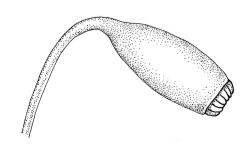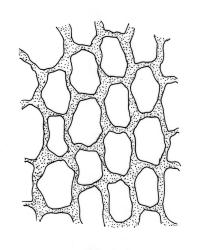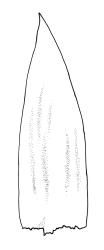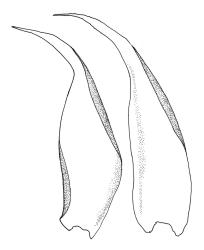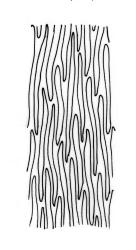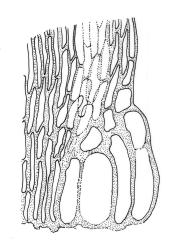- ≡ Hypnum tenuirostre Hook., Musci Exot. 2, 111 (1819)
- ≡ Rhaphidorrhynchium tenuirostre (Hook.) Mitt. in Brotherus, Nat. Pflanzenfam., ed. 2 [Engler & Prantl] 11, 428 (1925)
- ≡ Sematophyllum tenuirostre (Hook.) Dixon in Dixon & Bartram, Bot. Not. 1937: 83 (1937) nom. illeg.
Plants yellow-green to golden, rarely dark brown to nearly black, moderately lustrous or dull, hygrophilous, forming loosely interwoven mats. Stems irregularly or subpinnately branched, commonly 25–35 mm, in cross-section lacking a hyaloderm, with 3–4 layers of incrassate outer cells surrounding a core of thin-walled cells and lacking a central strand, c. 16 or more cells across. Branches variable in length, mostly <15 mm. Leaves strongly secund, usually ± falcate near branch tips, broadly ovate-lanceolate, abruptly tapered above to an acuminate apex, slightly narrowed to the base, concave and smooth, the margins denticulate above, plane or sometimes ± incurved near base, mostly 1.8–2.2(–2.5) × 0.45–0.70(–0.85) mm (under cover slip), ecostate; mid laminal cells (upper third of leaf) linear-vermicular, mostly 60–90 × 4–5 µm, commonly c. 20:1, firm-walled, smooth or with slightly projecting ends; basal cells shorter, porose, and pigmented; alar cells abruptly differentiated, consisting of 3–5 inflated, very large and thin-walled, hyaline or yellow cells in extreme angles, with few rows (1–3 rows) of supra-alar cells grading into laminal cells.
Autoicous. Perichaetia scattered on stems, the inner perichaetial leaves oblong-lanceolate, c. 2.0–2.3 mm, nearly entire, moderately plicate, with weakly differentiated alar cells, apparently expanding after fertilisation. Perigonia scattered on fertile stems, often numerous, c. 0.4–0.5 mm long, yellow or brown. Setae red at maturity, smooth, twisted weakly to the left, (9–)13–20 mm; capsules inclined to weakly pendulous, ovoid, with a short and ill-defined neck, yellow-brown at maturity, when dry constricted below the mouth and with the cells of the urn and neck distinctly bulging (visible under stereoscope), not narrowed below mouth but otherwise unchanged when moist, 1.3–1.7 mm; stomata few, in neck; operculum slenderly rostrate from a conic base, c. 1.0–1.2 mm; exothecial cells short round-oblong, not regularly arranged, strongly collenchymatous. Peristome as per genus; endostome with a high basal membrane and (0–)1–2, usually well-developed, nodose cilia. Calyptra cucullate, smooth, usually ± laciniate at base. Spores mostly 15–21 µm diam. but often quite variable (with some as small as 10 µm diam.) in a single capsule, green, smooth.
This species is sometimes confused with species of Brachythecium occupying stream margins, particularly B. plumosum. The presence of a costa and markedly different alar cells clearly differentiate these taxa, if microscopic examination is made.
NI: N Auckland, S Auckland (Hautapu River), Gisborne (Oronui Stream, Hopuruahine River) Taranaki (several localities in Egmont National Park), Wellington; SI: Nelson, Marlborough (s.loc.), Canterbury, Westland, Otago, Southland; St; Ch; A. Recorded from C by Vitt (1974, as Rhaphidorrhynchium tenuirostre).
Austral. Tasmania*, mainland Australia*. Recorded from South America by Ramsay et al. (2002).
On irrigated rock, soil over rock, and less often on wood in forest streams. Often in waterfall spray zones and occurring on a broad range of rock types including granite, marble, limestone, gneiss, schist, sandstone, greywacke, mudstone, and ultramafics. This species occurs throughout a broad elevation range, but appears intolerant of exposed alpine situations. It often forms extensive and ± pure mats of many square meters at stream or river margins. It can be particularly abundant and well-developed on flat rocks that are slightly submerged or emergent in the gentle flows of smaller forest streams, but it can also tolerate the full force of swiftly flowing water within cascades. On North I. from 160 (Kahuterawa Stream, Wellington L.D) to 1250 m (Manganui River in Egmont National Park, Taranaki L.D.). On South I. from <5 m (Dusky Sound, Southland L.D.) to 1240 m (Zetland Range, Nelson L.D.) elevation.
Sematophyllum uncinatum frequently forms pure and extensive colonies with no other bryophyte closely associated, although Brachythecium plumosum, Tridontium tasmanicum, and Thuidium laeviusculum often co-occur. Less frequent associates include Blindia magellanica, Brachythecium rutabulum, Cratoneuropsis relaxa, Dendrohypopterygium filiculaeforme, and Ochiobryum blandum.
The species varies little in its morphology, despite its occurrence on a remarkably broad range of substrates and over a broad elevational range. The most noticeably variable morphological feature is the width of the vegetative leaves, with leaves at the lower end of the range of continuous variation (c. 0.45 mm wide) seemingly associated with frequently emergent habitats. Forms with narrow leaves can occasionally be difficult to distinguish from Rhaphidorrhynchium amoenum, but that species appears to have consistently narrower leaves.






